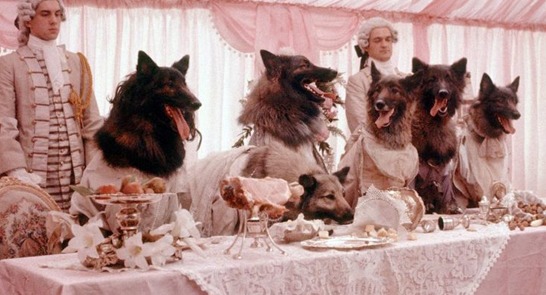
We’re very excited to have received the proofs for our forthcoming collection of essays, In the Company of Wolves: Werewolves, Wolves, and Wild Children – it looks fabulous! This book is published by Manchester University Press and will appear in February 2020. We’d like to thank all our wonderful contributors and MUP for making this possible.
The book emerged out of our very successful 2015 conference, ‘The Company of Wolves’: Sociality, Animality, and Subjectivity in Literary and Cultural Narratives—Werewolves, Shapeshifters, and Feral Humans. There are more details of the book here. We hope to have a launch party, perhaps as riotous as the one in the picture, together with a film screening, so keep following us for further news.
The book contents are:
List of figures
Notes on the contributors
Preface – Sam George
Acknowledgments
Introduction: from preternatural pastoral to paranormal romance – Sam George and Bill Hughes
Part 1: Cultural images of the wolf, the werewolf and the wolf child
1. Wolves and lies: a writer’s perspective – Marcus Sedgwick
2. ‘Man is a wolf to man’: wolf behaviour becoming wolfish nature – Garry Marvin
3. When wolves cry: wolf-children, storytelling, and the state of nature – Sam George
4. ‘Children of the Night, what music they make’: the sound of the cinematic werewolf – Stacey Abbott
Part 2: Innocence and experience: brute creation, wild beast or child of nature
5. Wild sanctuary: running into the forest in Russian fairy tales – Shannon Scott
6. ‘No more than a brute or a wild beast’: Wagner the Werewolf, Sweeney Todd, and the limits of human responsibility – Joseph Crawford
7. The inner beast: scientific experimentation in George MacDonald’s The History of Photogen and Nycteris – Rebecca Langworthy
8. Werewolves and white trash: brutishness, discrimination and the lower-class wolfman from The Wolf Man to True Blood – Victoria Amador
Part 3: Re-inventing the wolf: intertextual and metafictional manifestations
9. ‘The price of flesh is love’: commodification, corporeality, and paranormal romance in Angela Carter’s beast tales – Bill Hughes
10. Growing pains of the teenage werewolf: YA literature and the metaphorical wolf –Kaja Franck
11. ‘I am the Bad Wolf. I create myself’: the metafictional meanings of lycanthropic transformation in Doctor Who – Ivan Phillips
Part 4: Animal selves: becoming wolf
12. A running wolf and other grey animals: the various shapes of Marcus Coates –Sarah Wade
13. ‘Stinking of me’: transformations and animal selves in contemporary women’s poetry – Polly Atkin
14. Wearing the wolf: fur, fashion and species transvestism – Catherine Spooner
Bibliography
Index
